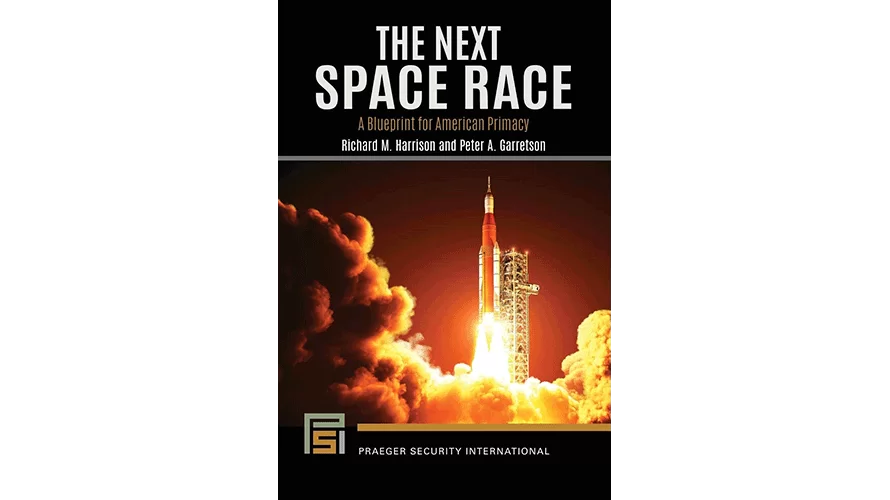Category: Nonfiction
Reviewed by: Casey Suire
Title: The Next Space Race: A Blueprint for American Primacy
Authors: Richard M. Harrison and Peter A. Garretson
Format: Hardcover/Paperback/Kindle
Pages: 248
Publisher: Praeger
Date: April 2023
Retail price: $77.00/$34.95/$16.98
ISBN: 978-1440880803
Find this book
“Space should not be thought of as a costly burden but, rather, as an investment consistently yielding solid returns.” This is one of many brilliant insights found in The Next Space Race: A Blueprint for American Primacy. The authors express their belief that it is crucial, for both economic and military reasons, that the United States remain first in space.
In the decades since losing the Space Race, Russia (formerly the Soviet Union) has arguably fallen to third place among major space nations. This book focuses on the country that has leapfrogged Russia in space capabilities: the People’s Republic of China (PRC). Since launching their first taikonaut,Yang Liwei, into orbit in 2003, China has boasted many dazzling achievements in the final frontier. In 2019, the PRC became the first nation to soft-land a spacecraft on the far side of the Moon. The next year, another Chinese spacecraft returned to Earth with samples of lunar soil. In 2021, Tianwen-1 became the first Chinese mission to successfully land on Mars. That same year, China launched the first module of the Tiangong space station.
As impressive as all of this sounds, China’s ambitions in space are just getting started. In the next few years, China hopes to operate a space telescope, Xuntian, in low-Earth orbit and build a lunar base with Russia called the International Lunar Research Station (ILRS). Other plans include “the development of techniques for asteroid mining, the creation of nuclear-powered shuttles for space exploration, and the industrialization of the Moon to fabricate satellites that can harness energy in space.” The book notes that the PRC wants “an Earth-Moon economic zone generating $10 trillion annually by the year 2050.”
China’s increasing success in space has gotten the attention of many involved with American space policy, including the authors of The Next Space Race. Unlike the PRC, which has a unified national space strategy focused on becoming the world’s leading space power by 2045, the United States “lacks a North Star vision for space.” For example, the book’s two main authors, Richard Harrison and Peter Garretson (a former member of the NSS Board of Directors) have a podcast called Space Strategy. It is noted that space advocates on the podcast have a variety of different rationales for developing space. While all these reasons are important, the various viewpoints often cause conflict among various factions. The authors recommend that a consolidated space strategy needs to be formed between “private-sector space companies, NASA, the Department of Commerce, the Department of Defense, Congress, and the White House.”
American space efforts are often negatively impacted by a lack of funding, a lack of will, and changes in political leadership. This is a problem the PRC doesn’t have. NASA’s human spaceflight plans are often subject to change when a new president or Congress takes office, resulting in billions of dollars and several years of wasted effort. NASA’s current Artemis lunar program has, so far, been supported by the last two presidential administrations. In recent years, the United States Space Force (USSF) has also been formed. One chapter is devoted to this new branch of the United States military.
This book is very well written. The writing style is straightforward and to the point. Despite being a relatively short book, The Next Space Race is very detailed and contains a lot of useful information about both U.S. and Chinese space policy. The only unusual aspect of the book is the cover, which is an image of NASA’s Space Launch System (SLS) lifting off. This is a strange choice considering that the authors criticize the massive booster’s high price tag (I presume it was chosen by the publisher rather than the authors). Then there is the book’s price. At nearly $80, the hardcover edition of The Next Space Race is very pricey. The paperback and Kindle versions, however, are significantly cheaper. One way to get the American public to support space exploration is to not hide great ideas in an expensive book.
In any case, the authors do a great job of explaining various topics with many very powerful and persuasive statistics. Despite the complaints about the SLS rocket, other sections of the book speak highly of NASA. For instance, it is mentioned that NASA has “provided many tangible benefits, such as technologies that have been readily adapted for everyday use on Earth—over 2,000 spin-off technologies were produced during the past 40 years.” Other statements note that spaceflight is becoming cheaper. For example, “the best cost to carry supplies to low Earth orbit has dropped from the Shuttle-era price of $54,500 per kilogram (kg) to $2,720/kg for a SpaceX-made Falcon 9 rocket.” The arrival of reusable rockets “has slashed the cost of carrying cargo into space by 85 percent over the past two decades.” Furthermore, the book also cites a NASA report that claims “the mineral wealth resident in the belt of asteroids between the orbits of Mars and Jupiter would be equivalent to about $100 billion for every person on Earth today.”
Overall, this is a great book that makes it clear that space is important for America’s future. The next few decades could, quite possibly, be the most thrilling in the history of space development. It will be important to see who leads the way.
© 2023 Casey Suire




















1 thought on “Book Review: The Next Space Race”
With Space X’s involvement, the consolidated space strategy is already being formed with NASA, and the rest of gov’t.